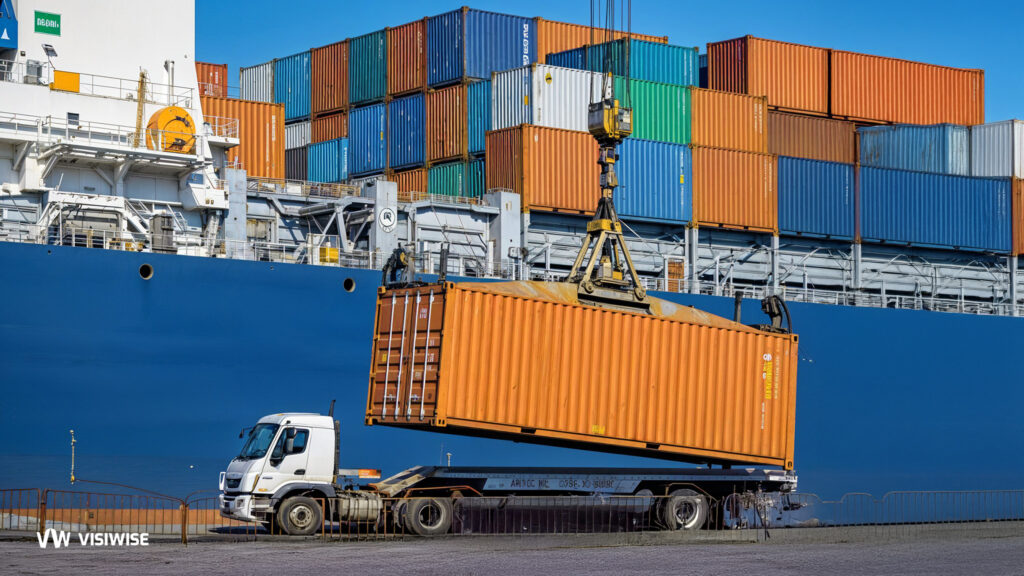Consumers are increasingly adamant about promoting eco-friendly practices, with McKinsey & Co. highlighting that 66% of consumers now prioritize sustainability. This growing demand is understandable, given the pressing need for environmentally responsible solutions.
In response, eco-friendly shipping has emerged as a vital aspect of business operations. It’s imperative for companies to integrate sustainable practices and embrace environmentally conscious strategies throughout their shipping processes.
Unsure of where to begin? Look no further – this article will guide you through the essential steps.
Comprehending Eco-Friendly Shipping
Eco-friendly shipping, also known as sustainable shipping or green logistics, involves conducting shipping operations with minimal negative impact on the environment. This encompasses various aspects such as packaging materials, transportation methods, energy consumption, and waste management. The concept gained traction as global environmental concerns escalated, prompting businesses to adopt more eco-conscious practices.
Initially emerging in the late 20th century, the focus was primarily on reducing emissions from vehicles. However, it soon expanded to address the environmental impact of packaging materials. Traditional materials like plastic and excessive cardboard were identified as significant contributors to pollution, leading to the exploration of alternatives such as biodegradable plastics and recycled cardboard.
Today, eco-friendly shipping has evolved into a holistic approach, integrating sustainable practices into every facet of the shipping process. Companies are increasingly turning to renewable energy sources, optimizing transportation routes for fuel efficiency, and exploring innovative packaging solutions. As sustainability becomes a paramount concern globally, eco-friendly shipping is poised to play an increasingly crucial role in logistics operations.
Why Is Shipping Sustainability Important?
Shipping sustainability plays a crucial role in several aspects:
- Environmental Preservation: Sustainable shipping practices help preserve the environment by reducing carbon emissions, minimizing pollution, and conserving natural resources. By prioritizing sustainability, businesses contribute to the protection of ecosystems and biodiversity.
- Carbon Emission Reduction: Sustainable shipping practices contribute to the reduction of carbon emissions, which are a significant contributor to climate change. By minimizing carbon emissions, businesses help mitigate the adverse effects of climate change and promote a healthier planet for future generations.
- Waste Minimization: Sustainable shipping practices help minimize waste generation by promoting the use of eco-friendly packaging materials and optimizing shipping routes. By reducing waste, businesses contribute to a cleaner environment and support efforts to combat pollution.
- Meeting Consumer Expectations: Consumers are increasingly prioritizing sustainability and environmental responsibility when making purchasing decisions. By embracing shipping sustainability, businesses meet consumer expectations and enhance their brand reputation.
- Long-Term Viability: Sustainable shipping practices contribute to the long-term viability of businesses by reducing operating costs, improving efficiency, and mitigating regulatory risks. By investing in sustainability, businesses future-proof their operations and ensure continued success in an increasingly environmentally conscious world.
Compelling Figures Highlighting the Significance of Eco-Friendly Shipping in 2024
Numerical data provides a vivid illustration of why eco-friendly shipping practices are paramount in 2024, shedding light on the motivations of both businesses and consumers to prioritize sustainability in the shipping sector:
- With a staggering 159 billion parcels shipped worldwide in 2021 alone, the projected annual increase of up to 11.5% through 2027 underscores the exponential growth of shipping volumes.
- Freight shipments already contribute to 30% of all fuel-related CO2 emissions globally, emphasizing the urgent need for greener shipping practices.
- A concerning statistic reveals that 91% of US packaging waste ends up in landfills or the environment, highlighting the pressing necessity for more sustainable packaging solutions.
- Stricter regulations such as the maximum allowed sulfur content in maritime fuel worldwide set at 0.5% m/m underscore the industry’s move towards cleaner fuel alternatives.
- The shipping industry’s significant consumption of oil, amounting to 201 million tons of oil equivalent (toe), emphasizes the importance of transitioning towards renewable energy sources.
- Despite efforts to mitigate emissions, only 14% of the global container fleet is fitted with scrubbers, indicating a substantial gap in implementing emission reduction technologies.
- Alarmingly, the logistics and transport sector contributes over a third of global CO2 emissions, necessitating urgent action to curb its environmental impact.
- Projections for the green logistics market indicate a Compound Annual Growth Rate (CAGR) of 6.1% through 2028, reflecting the increasing demand for sustainable shipping solutions.
- The electric delivery vehicle market is poised for exponential growth, with projections estimating it to reach $44.3 billion by 2030, emphasizing the shift towards cleaner transportation alternatives.
- Business leaders recognize the imminent impact of climate change on their operations, with 61% foreseeing a high or very high impact over the next three years, driving investments towards sustainability initiatives.
- A significant majority (59%) of companies began incorporating more environmentally friendly materials in 2023, indicating a shift towards greener product choices.
- Encouragingly, 75% of leaders have increased their investments in sustainability initiatives in the past year, with a notable 20% reporting significant increases, reflecting a growing commitment to a sustainable future.
- Employee activism plays a crucial role in driving sustainability efforts, with more than half of leaders attributing increased investments in sustainability to employee advocacy.
- Regulatory pressure also motivates businesses to invest in climate change initiatives, with 65% of CxOs acknowledging the regulatory environment as a driving force behind their sustainability investments.
- In 2024, businesses identify climate change as the second most pressing issue affecting their operations (42%), closely trailing economic prospects (44%), highlighting the growing recognition of environmental concerns in shaping business strategies.
These statistics underscore the imperative for businesses to embrace eco-friendly shipping practices in 2024 and beyond, aligning with evolving consumer expectations and regulatory mandates while mitigating their environmental footprint.
Benefits of Eco-Friendly Shipping
While the transition may pose initial challenges, businesses embracing eco-friendly shipping practices stand to gain numerous advantages:
A. Cost Savings
Implementing eco-friendly shipping practices can yield significant cost savings for businesses. Through optimizing packaging, reducing fuel consumption, and minimizing waste, companies can drive down their operational expenses tied to shipping. Moreover, investments in sustainable transportation options, such as electric vehicles or alternative fuels, promise long-term cost reductions via lower fuel and maintenance expenditures.
Estimated Cost Savings:
- Optimized Packaging: 20% or more
- Reduced Fuel Consumption: Even a conservative 5% reduction in fuel consumption could translate to substantial annual savings, potentially reaching up to $100,000 per vessel. Calculations based on a consumption rate of 30 tons per day, priced at $250 per ton, over 280 days at sea.
- Minimizing Delivery Waste: 60% or more
- Route Optimization: 20% or more
- Use of Electric Vehicles: Electric vehicles from the 2017 model year offer savings of approximately $1,100, while those from the 2018 model year provide savings of around $500.
B. Brand Differentiation
Adopting eco-friendly shipping not only showcases a dedication to environmental stewardship but also distinguishes businesses from competitors. In today’s market, consumers are increasingly mindful of the environmental repercussions of their purchases and are more inclined to support brands prioritizing sustainability. According to Forbes, two-thirds of consumers express willingness to pay a premium for sustainable brands. By integrating eco-friendly shipping practices, companies can set their brand apart, attract environmentally conscious consumers, and foster brand loyalty.Top of Form
C. Long-Term Environmental Preservation
Arguably the most significant benefit of eco-friendly shipping lies in its contribution to long-term environmental preservation. By reducing carbon emissions, particularly through optimizing transportation and minimizing waste, especially in return management, eco-friendly shipping practices actively mitigate the adverse effects of climate change and safeguard ecosystems. Through the adoption of sustainable shipping methods, businesses play a pivotal role in preserving the environment for future generations.
D. Reduced Regulatory Risks
Prioritizing eco-friendly shipping also translates to reduced regulatory risks for companies. With governments worldwide implementing stricter environmental regulations, businesses that fail to comply may face fines, penalties, or reputational damage. Proactively embracing sustainable shipping practices allows businesses to stay ahead of regulatory requirements and mitigate potential risks associated with non-compliance.
E. Enhanced Corporate Social Responsibility
Eco-friendly shipping aligns seamlessly with broader corporate social responsibility (CSR) initiatives, underscoring a company’s commitment to environmental stewardship and social accountability. By integrating sustainable practices into their supply chain and shipping operations, businesses not only enhance their reputation but also strengthen relationships with stakeholders. Moreover, they contribute meaningfully to the greater good of society by reducing their environmental footprint and promoting sustainable development.
Adopting Sustainable Shipping Strategies: Key Approaches to Consider
The logistics industry is witnessing a surge in last-mile delivery trends and innovations. Despite this, businesses must prioritize sustainable shipping practices not only to contribute to a greener planet but also to enhance their overall operations. Here are five expert-recommended strategies to help businesses reduce their environmental footprint:
A. Adoption of Alternative Fuels: Embracing alternative fuels like biodiesel, hydrogen, and natural gas can significantly slash carbon emissions. To implement this strategy effectively, businesses should conduct thorough research to identify the most suitable alternative fuel options for their fleets. Collaborating with energy experts or consultants can provide valuable insights into the availability, cost-effectiveness, and environmental benefits of various alternative fuels.
B. Transition to Energy-Efficient Transportation Modes: Shifting to energy-efficient transportation modes such as electric vehicles (EVs) and hybrid trucks is a pivotal step towards sustainable shipping. To execute this strategy successfully, businesses should carefully assess their transportation needs and evaluate the feasibility of integrating EVs or hybrid vehicles into their fleets. Partnering with manufacturers and suppliers specializing in eco-friendly transportation solutions can facilitate a smooth transition and ensure optimal vehicle performance.
C. Adoption of Eco-Friendly Packaging Materials and Designs: Selecting eco-friendly packaging materials and designs is crucial for reducing waste and mitigating environmental impact. When implementing this strategy, businesses should prioritize materials such as recycled cardboard, biodegradable plastics, and compostable packaging. Close collaboration with packaging suppliers and designers can ensure that packaging solutions align with sustainability goals while upholding product integrity and safety.
D. Optimization of Shipping Routes: Efficiently optimizing shipping routes is vital for minimizing carbon emissions and fuel consumption. Leveraging advanced route optimization software and data analytics tools can help businesses pinpoint the most efficient routes based on factors like distance, traffic patterns, and delivery schedules. Collaborating with logistics experts or consultants can offer valuable insights into route optimization strategies and best practices.
E. Utilization of Delivery Software: Integration of delivery software, particularly for last-mile deliveries, can streamline operations and boost efficiency across the shipping process. By investing in advanced delivery management systems, businesses can optimize delivery routes, track shipments in real-time, and mitigate delays. When selecting delivery software, businesses should prioritize solutions offering eco-friendly features such as carbon footprint tracking and emission reduction tools.
F. Leveraging a Real-time Visibility Platform: Using a visibility platform provides real-time insights into the entire supply chain, enabling businesses to monitor and optimize their shipping processes. By leveraging data analytics and visibility tools, companies can identify inefficiencies, reduce waste, and make informed decisions to enhance sustainability. Integrating a visibility platform as part of sustainable shipping practices ensures transparency and accountability while driving continuous improvement across the supply chain.
How to Make Your Shipments Eco-Friendly with a Real-Time Visibility Platform
Understanding Your Supply Chain
Understand your current supply chain operations and identify areas where eco-friendly practices can be implemented, spanning transportation, packaging, warehousing, and distribution.
Optimizing Transportation
Use the real-time visibility platform to analyze routes and select efficient and eco-friendly options, such as rail or consolidating shipments, to reduce carbon emissions and fuel consumption.
Implement measures such as using hybrid or electric vehicles, optimizing loading for efficiency, and encouraging eco-friendly driving practices to reduce emissions during transportation.
Sustainable Packaging and Energy Management
Opt for sustainable materials like recycled cardboard and track packaging usage to minimize waste. Use the visibility platform to identify opportunities for optimization, such as reducing excess packaging or implementing reuse programs.
Utilize the platform to track energy use in facilities and implement energy-saving measures like LED lighting and motion sensors to reduce environmental impact.
Monitoring and Collaboration
Monitor key metrics such as carbon emissions, energy consumption, and waste generation using the visibility platform. Set targets for improvement and regularly monitor progress towards sustainability goals.
Work closely with suppliers and logistics partners to promote eco-friendly practices throughout the supply chain. Encourage the use of sustainable materials and transportation methods and collaborate on joint initiatives such as transportation planning and shared warehousing facilities.
Continuous Improvement
Regularly review and optimize eco-friendly shipping practices based on data and feedback from the visibility platform. Look for new opportunities to reduce environmental impact and improve sustainability across the supply chain.
By integrating these steps into your shipping operations and leveraging a real-time visibility platform, you can effectively make your shipments more eco-friendly while also improving efficiency and reducing costs.
Eco-Friendly Shipping Boxes: Comprehensive Insights
The surging demand for eco-friendly packaging among UK consumers is undeniable, evidenced by a 64% increase in the likelihood of purchase when packaging is sustainable.
In the realm of eco-friendly shipping, the focus extends far beyond mere utilization of standard brown boxes for packaging. Sustainable packaging embodies a holistic approach, considering materials employed, packaging size, and overall environmental impact.
A crucial facet of eco-friendly shipping boxes lies in utilizing precisely the required size for the product. Superfluous space not only adds unwarranted weight but also escalates material consumption, thereby impacting sustainability. Opting for custom-sized boxes tailored to snugly accommodate the contents enables businesses to curtail waste and diminish their environmental footprint.
Furthermore, sustainable packaging transcends the realm of boxes alone. It encompasses minimizing the utilization of ancillary packaging materials such as bubble wrap, plastic strings, and adhesive tapes. Instead, businesses can explore alternatives such as recyclable paper-based cushioning, biodegradable packing peanuts, and eco-friendly adhesive tapes. By mitigating reliance on non-biodegradable materials, businesses can augment the eco-friendliness of their shipping practices.
However, it’s imperative for businesses to grasp that eco-friendly shipping extends beyond sustainable packaging. Even with eco-friendly boxes, an unsustainable supply chain renders efforts futile.
Final Thought
In conclusion, implementing eco-friendly shipping practices with the aid of a real-time visibility platform offers a multifaceted approach to sustainability in the logistics industry. By understanding and optimizing various aspects of the supply chain, including transportation, packaging, and energy management, businesses can significantly reduce their environmental footprint while enhancing efficiency and reducing costs. Through continuous monitoring, collaboration with partners, and a commitment to ongoing improvement, companies can navigate towards a more sustainable future, where eco-conscious practices are not just a trend but a fundamental aspect of successful operations. Embracing eco-friendly shipping practices with the support of technology underscores a commitment to environmental stewardship while driving positive impacts across the supply chain and contributing to a healthier planet for future generations.



